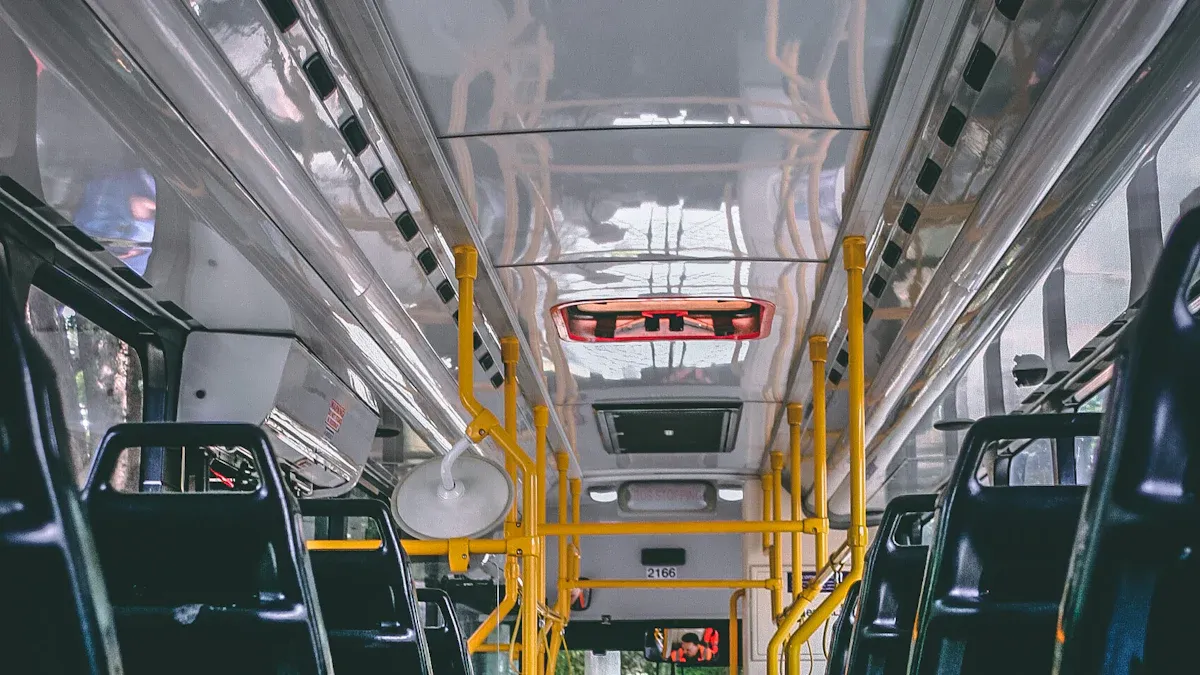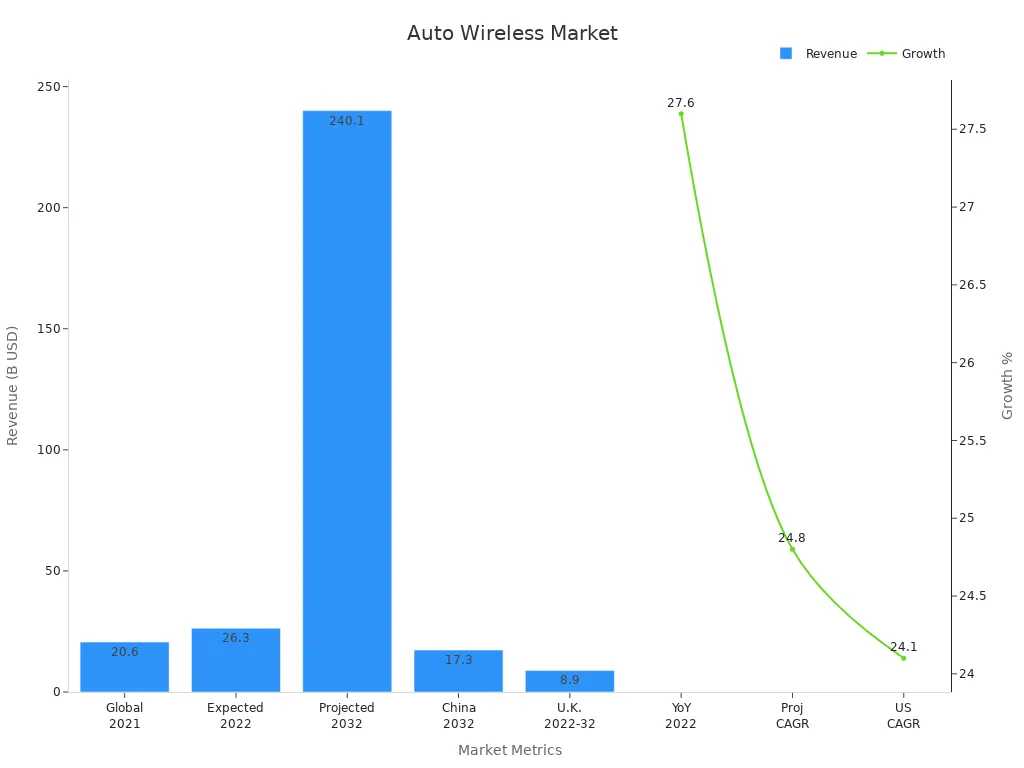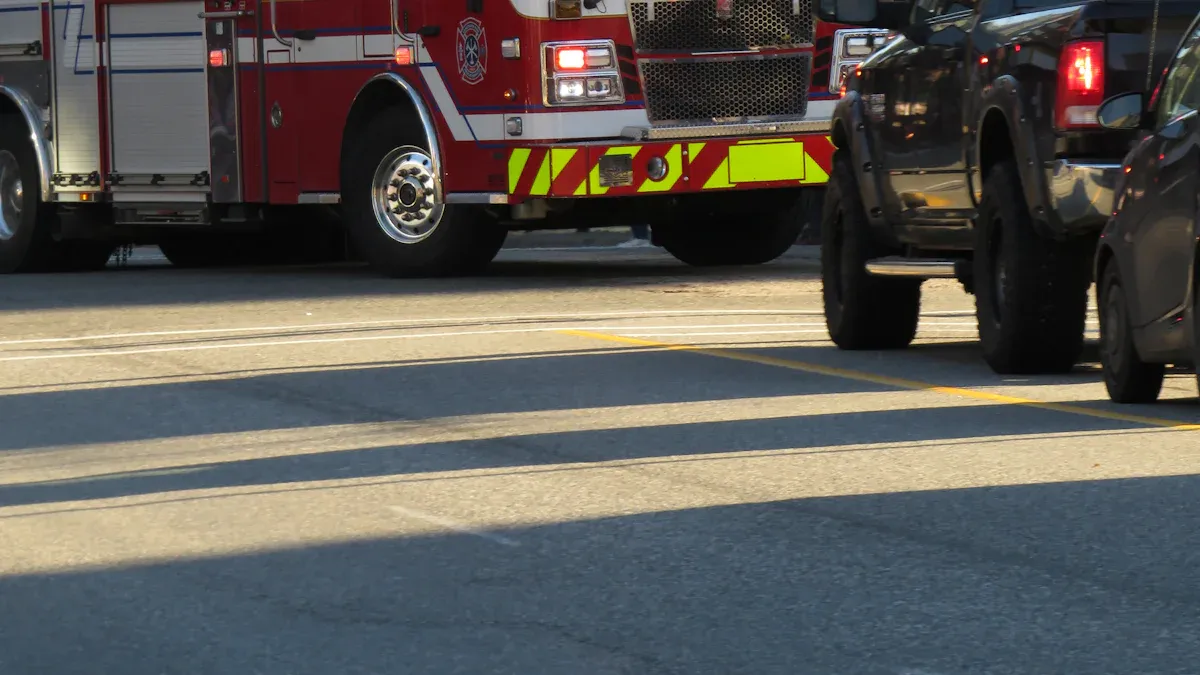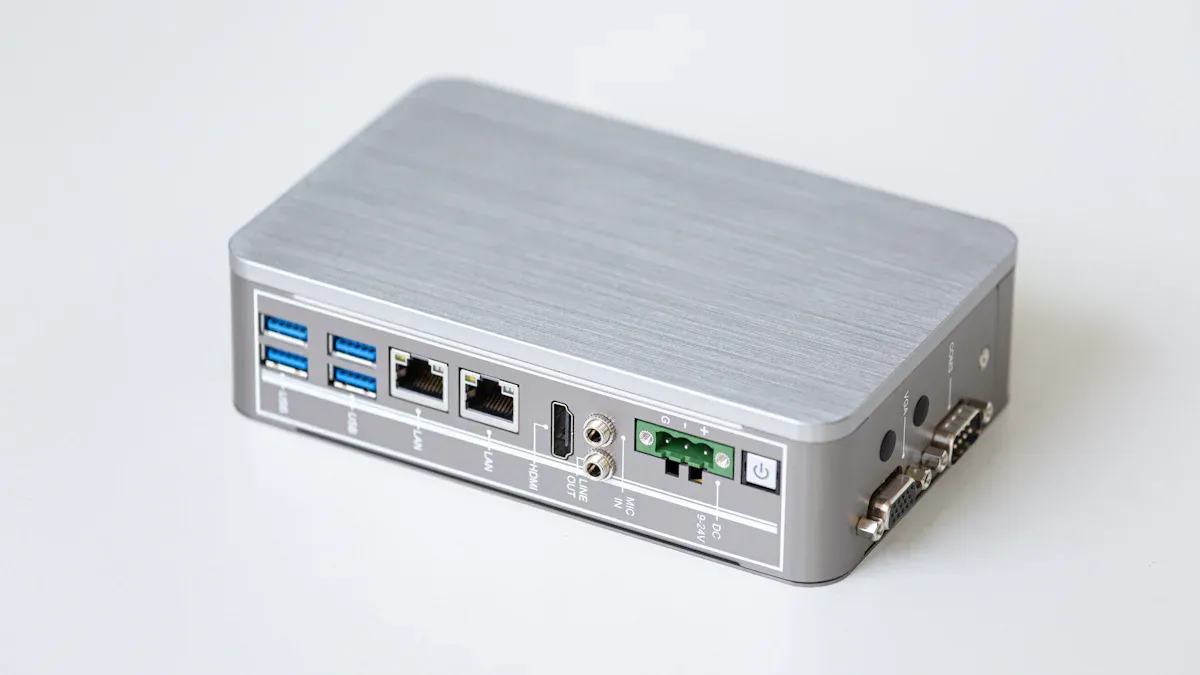
Automotive wireless routers play a vital role in transit and transportation, delivering secure and reliable connectivity for first responders in mission critical situations. HUASIFEI stands out with advanced 5G router technology, global R&D centers, and a broad product range that meets the demands of rugged environments. Leading brands like Sierra Wireless, Peplink, Cradlepoint, Digi, and Cisco also drive innovation in 5G and WiFi solutions for public safety and transit. The market for automotive wireless routers continues to expand rapidly, fueled by the need for real-time data and advanced vehicle communication.

Why Router Choice Matters
Mission-Critical Needs
Transit and transportation agencies depend on automotive wireless routers to deliver always-on connectivity in the field. For first responders, every second counts during emergencies. Reliable cellular communication ensures that teams can share real-time data, access critical applications, and coordinate responses without delay. Safety remains the top priority, so routers must withstand harsh conditions and maintain high performance in moving vehicles.
The performance of these routers is measured using several key metrics. The table below outlines the most important ones for mission critical operations:
| Métrica | Descripción | Formula / Explanation |
|---|---|---|
| Packet Loss Rate (PLR) | Measures lost packets, indicating communication quality. | PLR = Lost packets / Total packets sent |
| Packet Failure Rate (PFR) | Tracks failed communications, showing reliability of packet delivery. | PFR = Failures / Total packets sent |
| Probability of Failure per Hour (PFH) | Shows failures normalized by test duration. | PFH = Failures / Test hours |
| Round Trip Time (RTT) | Measures latency for sending and receiving packets. | Measured experimentally |
| Received Signal Strength Indicator (RSSI) | Indicates link quality and robustness. | Measured in dBm |
These metrics, tested over 1000 hours in real-world environments, ensure routers meet strict requirements for reliability and timely message delivery—often under 100 seconds in emergencies.
Other important indicators include packet delivery ratio, signal to noise ratio, and end-to-end data delivery reliability. These factors guarantee that public safety support systems function without fail.
Key Selection Factors
Selecting the right router for transit and transportation fleets involves more than just speed. Agencies must consider:
- Multi-cellular support for seamless switching between carriers, reducing the risk of dropped connections.
- 5G or 4G LTE technology, which delivers data speeds up to 10 times faster than previous generations and ultra-low latency for real-time operations.
- High throughput to support multiple devices, such as body cameras, mobile data computers, and sensors, all running simultaneously.
- Rugged routers designed for harsh environments, ensuring durability and safety in transit vehicles.
- Advanced security features, like WPA3, to protect sensitive data and maintain public safety support.
5G enables advanced applications, including live video streaming and sensor integration, with minimal delay. Enhanced connectivity and reliability improve situational awareness and response times for first responders. Agencies in transportation and transit require routers that deliver robust, secure, and always-on connectivity to keep operations running smoothly.
Top Automotive Wireless Routers

Selecting the right automotive wireless routers can transform connectivity for public safety and transit fleets. Several leading brands stand out for their innovation, reliability, and advanced features. Each brings unique strengths to the table, supporting mission-critical operations in transportation and beyond.
HUASIFEI Visión general
HUASIFEI has established itself as a global leader in automotive wireless routers, offering a diverse product range that meets the demands of modern transit and public safety. The company produces Dispositivos compatibles con OpenWRT, including 4G and 5G routers, mesh systems, and industrial routers. HUASIFEI integrates advanced technologies such as WiFi-6, WiFi-6E, and WiFi-7, ensuring high-speed connectivity and future-proof performance.
Their routers support 5G and high-power 5g mmwave radios, delivering ultra-fast data rates and low latency. HUASIFEI partners with top chipset manufacturers like Mediatek, Broadcom, and Qualcomm, which enhances hardware reliability and performance. The company’s manufacturing facility employs about 700 people and maintains strict quality control. International certifications such as CE, ROHS, and FCC reflect the reliability and safety of their products.
HUASIFEI’s routers serve clients in over 30 countries, supporting a wide range of applications from transit vehicles to industrial IoT. The company’s dedicated R&D team drives continuous innovation, focusing on features like IPv6 support, router advertisement services, and robust security protocols. HUASIFEI also offers OEM and ODM customization, allowing agencies to tailor solutions for unique operational needs.
HUASIFEI’s commitment to innovation and quality makes it a top choice for agencies seeking advanced automotive wireless routers with global support.
Sierra Wireless
Sierra Wireless stands as a pioneer in cellular routers for transportation and public safety. The company’s AirLink series, including the MP70, XR90, and MG90, delivers ruggedized gigabit-class lte router solutions designed for harsh environments. These routers support multi-carrier 5G and LTE connectivity, ensuring reliable communication for transit fleets and emergency vehicles.
Sierra Wireless focuses on IoT integration, enabling real-time data sharing and advanced fleet management. Their routers feature strong security protocols, remote management, and seamless integration with vehicle systems. The AirLink XR90, for example, supports 5g fixed wireless access and multiple high-speed connections, making it ideal for mission-critical applications.
Peplink
Peplink has earned a reputation for robust connectivity and advanced security in automotive wireless routers. The MAX Transit Duo Pro and SDX models offer multi-WAN, LTE, and 5G capabilities. Intelligent load balancing and automatic failover ensure continuous high-speed connectivity, minimizing downtime for transit and public safety operations.
Key features include AES-256 encryption, stateful firewall, and integrated VPN protocols such as IPSec and OpenVPN. Peplink’s modular design allows easy integration with legacy systems and future network expansion. Cloud-based management software provides real-time monitoring and remote configuration, enhancing operational efficiency. The rugged design of Peplink routers supports deployment in challenging environments, making them suitable for both transit and industrial applications.
- Peplink SDX supports 5G technology, delivering ultra-low latency and high throughput.
- Load balancing distributes traffic evenly, optimizing bandwidth and reducing latency.
- Real-world deployments show improved operational efficiency and secure data transfer in sectors like healthcare and manufacturing.
Cradlepoint
Cradlepoint leads the market with advanced wireless edge solutions for transit and public safety. Their routers support both 4G LTE and 5G, providing reliable cellular connectivity for vehicles on the move. Cradlepoint’s solutions integrate with telecom partners to deliver seamless coverage and high-speed data transfer.
The company emphasizes ruggedness, designing routers to withstand vibration, temperature extremes, and other challenges common in transportation. Cradlepoint routers offer strong security features, including VPN support and advanced threat protection. Their cloud-based management platform enables agencies to monitor and manage fleets remotely, ensuring optimal performance and quick troubleshooting.
Digi and Cisco
Digi International and Cisco both deliver high-performance cellular routers for demanding transit and public safety environments. Digi’s TX40 model specializes in secure, reliable connectivity for industrial IoT and machine-to-machine (M2M) applications. The TX40 supports 5G and advanced security protocols, making it suitable for mission-critical deployments.
Cisco offers a wide range of industrial cellular routers, focusing on innovation and cybersecurity. Their routers support edge computing, IoT integration, and multi-carrier connectivity. Cisco’s solutions are known for their rugged construction and ability to operate in harsh conditions, making them a trusted choice for transportation agencies worldwide.
| Brand | Notable Models | Características principales | Lo mejor para |
|---|---|---|---|
| HUASIFEI | 5G Car WiFi, OpenWRT | 5G, WiFi-6/6E/7, global support, customization | Transit, public safety, IoT |
| Sierra Wireless | MP70, XR90, MG90 | Rugged, multi-carrier, 5G/LTE, IoT integration | Emergency, transit, fleet |
| Peplink | MAX Transit Duo Pro, SDX | Multi-WAN, 5G, load balancing, cloud management | Transit, industrial, healthcare |
| Cradlepoint | IBR Series, R1900 | 4G/5G, rugged, cloud-managed, security | Transit, public safety |
| Digi | TX40 | 5G, secure, industrial IoT, M2M | Industrial, transit |
| Cisco | IR1101, IR829 | Rugged, 5G, edge computing, cybersecurity | Transportation, public safety |
These brands continue to drive innovation in automotive wireless routers, focusing on connectivity, security, and ruggedness. Their solutions support the evolving needs of transit and public safety agencies, ensuring reliable communication in every scenario.
Comparación de modelos

Features & Specs
A clear router comparison helps agencies select the best solution for their needs. The table below highlights key differences in connectivity, security, and ruggedness among top automotive wireless routers:
| Modelo | Conectividad | Seguridad | Ruggedness/Certifications | Características únicas |
|---|---|---|---|---|
| HUASIFEI 5G Car WiFi | 5G/4G LTE, WiFi 6/6E/7 | WPA3, VPN, IPv6, customizable firmware | CE, ROHS, FCC, industrial design | OpenWRT, global support |
| Sierra Wireless XR90 | Dual 5G/4G LTE, WiFi 5 | VPN, FirstNet Ready, remote management | MIL-STD 810G, IP64, wide temp range | IoT integration, fleet tracking |
| Peplink SDX | Multi-WAN, 5G, WiFi 6 | AES-256, IPSec/OpenVPN, firewall | Modular, -40°C to 65°C | Load balancing, cloud management |
| Cradlepoint R1900 | 5G/4G LTE, WiFi 6 | VPN, advanced threat protection | MIL-STD 810G, IP64, vibration resistant | Edge computing, cloud-managed |
| Digi TX64 5G | Dual 5G/4G LTE, WiFi 5, Bluetooth 5 | VPN, FirstNet Trusted, data segmentation | MIL-STD 810G, -34°C to 74°C, rail cert. | Bluetooth mesh, rail ready |
This router comparison shows how each model addresses connectivity and security. For example, Digi’s TX64 5G offers dual cellular modules and Bluetooth 5 mesh, which performed well in public transit tests, showing only 0.16% packet loss even in crowded buses.
Pros & Cons
Each router comparison reveals strengths and trade-offs:
HUASIFEI 5G Car WiFi
- Pros: Advanced connectivity, customizable firmware, global support
- Cons: Limited public case studies in North America
Sierra Wireless XR90
- Pros: Dual cellular, rugged, FirstNet Ready
- Cons: Higher cost for advanced features
Peplink SDX
- Pros: Modular, scalable, strong security, load balancing
- Cons: May require technical setup for full features
Cradlepoint R1900
- Pros: Rugged, cloud-managed, edge computing
- Cons: Premium pricing
Digi TX64 5G
- Pros: Dual cellular, Bluetooth 5 mesh, rail certification
- Cons: WiFi 5 standard, not WiFi 6
Agencies should use router comparison tables to weigh these factors against operational needs.
Mejores casos de uso
A router comparison highlights which models excel in specific scenarios:
- Public Safety Fleets: Sierra Wireless XR90 and Cradlepoint R1900 deliver reliable connectivity and low latency for emergency response.
- Transit Buses and Rail: Digi TX64 5G, with Bluetooth 5 mesh, suits public transit, as proven by real-world bus deployments.
- Industrial IoT: HUASIFEI and Digi models support industrial-grade environments and offer flexible customization.
- Budget-Conscious Agencies: HUASIFEI provides advanced features and global support at competitive pricing.
- Scalable Fleets: Peplink SDX stands out for modular design and easy expansion.
A thorough router comparison ensures agencies match the right router to their connectivity, security, and ruggedness requirements.
Elegir el router adecuado
Selecting the best automotive wireless router for transit and public safety fleets requires careful planning. Agencies can use a step-by-step approach to match routers to their unique needs.
Agency & Fleet Size
Agencies with large fleets often need routers that support many simultaneous connections and centralized management. Smaller fleets may prioritize ease of installation and cost-effectiveness. A large transit agency benefits from routers with advanced monitoring tools and remote updates. Smaller teams can choose compact models that deliver reliable connectivity without complex setup.
Tip: Agencies should estimate the number of vehicles and connected devices before choosing a router.
Vehicle Types
Different vehicles present unique challenges for wireless routers. Buses, patrol cars, and trains each have specific mobility patterns. Empirical data shows that as vehicle speed increases from 5 to 60 km/h, end-to-end delay and throughput can change. For example, routers with quality-based neighbor selection maintain low delay up to 30 km/h, while others see delays rise above 20 km/h. High vehicle density, such as 500 vehicles in a busy transit corridor, can also affect throughput. Routers designed for stable performance in dense or fast-moving environments help transit agencies stay connected on-the-go.
| Vehicle Condition | Métrica de rendimiento | Observed Effect |
|---|---|---|
| Increasing Speed (5–60 Km/h) | End-to-End Delay | Low delay up to 30 Km/h; higher delay above 20 Km/h |
| Increasing Speed (5–60 Km/h) | Rendimiento | Gradual decrease; less sharp with quality selection |
| Increasing Density (100–500) | End-to-End Delay | Minimal increase with quality-based routers |
| Increasing Density (100–500) | Rendimiento | Stable with quality-based routers |
Connectivity Needs
Transit and transportation agencies must consider the number of devices, data speed, and security requirements. Fleets using live video, GPS tracking, and IoT sensors need routers with high-speed 5G or WiFi 6/7. Agencies handling sensitive information should look for routers with WPA3 security and VPN support. HUASIFEI offers a solution with customizable firmware and advanced security, making it suitable for agencies with unique connectivity needs.
Budget Factors
Budget plays a key role in router selection. Agencies should balance upfront costs with long-term value. Some routers offer advanced features at a premium price, while others provide essential connectivity at a lower cost. HUASIFEI supports a range of budgets and offers ODM customization, allowing agencies to tailor routers for specific transit applications without overspending.
Agencies can use this checklist to guide their decision:
- Assess fleet size and management needs
- Match router features to vehicle types and mobility patterns
- Identify required connectivity, speed, and security
- Set a realistic budget and explore customization options
Public safety fleets benefit from Sierra Wireless and Cradlepoint routers, which deliver rugged performance and low latency. Transit agencies often choose Digi or Peplink for scalable, secure connectivity. HUASIFEI stands out for innovation, global support, and advanced 5G features.
Agencies seeking reliable, customizable solutions should consider HUASIFEI for both large and small fleets. Matching router features to operational needs ensures safe, efficient, and future-ready transit and public safety operations.
PREGUNTAS FRECUENTES
What makes automotive wireless routers suitable for public safety and transit?
Automotive wireless routers use rugged hardware, advanced security, and multi-carrier 5G or LTE support. These features ensure reliable, high-speed connectivity for vehicles in motion. Agencies depend on these routers for real-time data, GPS, and secure communication during emergencies.
How does HUASIFEI support customization for unique fleet needs?
HUASIFEI offers ODM and OEM services. Agencies can request custom firmware, hardware configurations, and branding. This flexibility allows fleets to match routers to specific operational requirements, ensuring optimal performance and seamless integration with existing systems.
Which certifications should agencies look for in automotive routers?
Agencies should check for CE, ROHS, and FCC certifications. These standards confirm product safety, electromagnetic compatibility, and environmental compliance. Certified routers meet international quality benchmarks, making them suitable for deployment in public safety and transit environments.
Can automotive routers handle multiple connected devices at once?
Yes. Leading models like HUASIFEI, Sierra Wireless, and Peplink support dozens of simultaneous connections. These routers use high-throughput WiFi (such as WiFi 6/6E/7) and advanced load balancing to maintain stable performance for cameras, sensors, and mobile computers.
Why is 5G important for transit and public safety routers?
5G technology delivers faster speeds, lower latency, and higher capacity than previous generations. Agencies benefit from real-time video streaming, instant data uploads, and improved situational awareness. 5G routers help fleets respond quickly and operate efficiently in demanding scenarios.